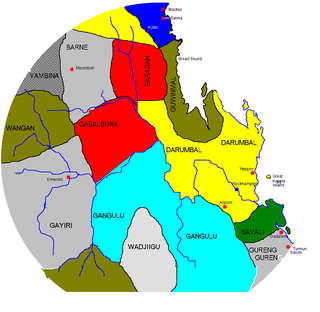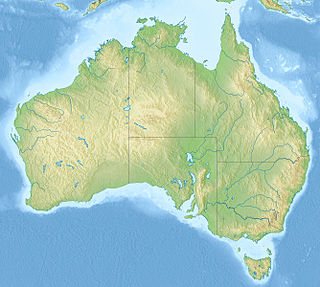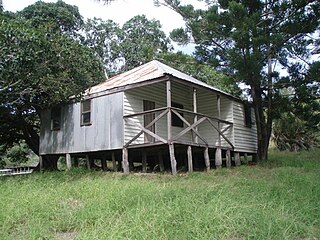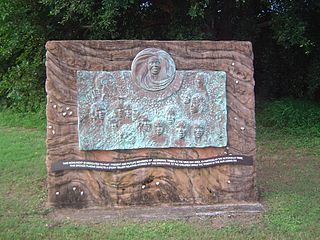History
According to Michael Rowland, an authority on the Woppaburra writing in part to reply to the skepticism about reports of genocide advanced by Keith Windschuttle, the first visit of whites to the island occasioned a massacre of seven/eight members of the tribe: not mentioned in the report of the expedition, which spoke of an incident in which a fleeing gin, or aboriginal woman, had been saved by the group after she fell into the sea and injured herself, this or perhaps an earlier occasion of slaughter, was pointed out by tribal people later, who showed a hundred-yard line pitted with the skeletal remains of the Woppaburra who had been killed., [8] and several males, accused of killing some sheep, were transported off the terrain, to Yeppoon, where the local tribes viewed them with hostility. The then lessee however stated that a full 30 had been removed, at their request, to the mainland, and relocated, after landing at a place 10 miles south of Cape Manifold, at the Water Park Native Reserve, while leaving only two native women (gins) behind. [3] Robert Ross's pastoral lease ran 3-4,000 sheep on island. [9] Another white version at the time (1883) claimed that the Woppaburra were not native to the island but had managed, being part of a mainland tribe, to get over to the island and kill a 100 sheep, and that this accounted for their removal. [10] According to testimony given to Walter Roth, however, some whites and mainland blacks had descended on the island, and hunted up all the Woppaburra women and children they could find, and had them transported back to the coast. 'Human lives were sacrificed for sheep,' was his conclusion. [11] Ross may have shifted them to the mainland to supply cheap labour for property at Taranganba. [12]
Keith Windschuttle is an Australian writer, historian, and former ABC board member.

Yeppoon is a coastal town and locality in the Shire of Livingstone, Central Queensland, Australia. Yeppoon is renowned for its beaches, tropical climate, and the islands out on the bay. Twenty-five minutes from the city of Rockhampton, Yeppoon is the principal town on the Capricorn Coast, a string of seaside communities stretching more than 150 kilometres (93 mi) from north to south. The beaches and shallow coves provide a destination both for tourists and miners settling down in Central Queensland. Offshore, there are 27 islands including Great Keppel Island which is 20 kilometres (12 mi) from Yeppoon.
Cape Manifold is a coastal headland in central Queensland, Australia.
Deracinated on the mainland, and unable to adapt to Yeppoon conditions, where they eventually were said to have retired to, reports quickly noted that the transported group was rapidly dying off -though one man, Yoolowa/Lowoo, was said to have swum back to Keppel island and others were eaten by sharks in attempts to get back to their homeland- as a result of "coast fever" and an inability to live off the different diet. Corpses of Woppaburra were found here and there in scrubland and along the beaches. [13] Reports from the mid-1880s indicate that some Woppaburra remained on the island, used as cheap labour on the sheep-runs, men and women whipped along as, harnassed to a plough, they were forced to furrow the soil, and fed tidbits thrown their way by whites. They were chained to a tidal cave if they refused to work. [11]
Something akin to frontier warfare, involving not only shootings, poisonings, and being driven into the sea, but also theft of their women by Japanese pearlers, appears to have struck the Woppaburra, according to the tales handed down by descendants of the tribe in both Yeppoon and Emu Park
Ross's Keppel interests were taken over by his foreman, James Lucas, in 1897 and he moved the Woppaburra to South Keppel island near his homestead. At the same time, in the late 1890s, a dispute over territorial competence arose between the northern protector of Queensland's aboriginal peoples, and his southern colleague Archibald Meston. Roth they insisted not be dislocated from the islands, and was thought to favour the lessee's interests, while Meston was shocked by the degraded conditions to which the Woppaburra had been reduced in the introduced pastoralist environment. [14] Roth reported 19 Woppaburra full-bloods on the island in 1898, 3 of them male, and 16 female, a disparity he attributed to the character of the Europeans who frequented the isle. Meston wanted them shifted to Fraser Island to isolate them from sexually predatory whites and fishermen. [15]
The remnants of the Woppaburra were forcibly removed from the island in 1902, [16] though one descendant claims his family was removed 8 years later, in 1910. The skeletal remains of 2 Woppaburra people were removed to museum holdings in London, in the 1920s, and were conserved at the Royal College of Surgeons and London's Natural History Museum. In the early 1980's The keppel Islands Lifestyle Aborigninal Corporation (K.I.L.A.C) was formed by the initiative of Woppaburra descendants Elders Aunty Glenice Croft, Aunty Linette Van Issum, Uncle Robert Barney, Aunty Ethel Richards, Aunty Heather Saunders, Aunty Ruthy Cummings and their children Michelle Croft, Angela & Sonny Van Issum. Where the K.I.L.A.C media person Aunty Glenice Croft contacted Michael Rowland after media coverage about Mr Rowland's archaeological survey on the Keppel Islands he meant Aunty Ethel Richards, Aunty Glenice Croft and others which lead to the first Woppaburra reunion return in 1984 when 40 descendants met up on Great Keppel island.












